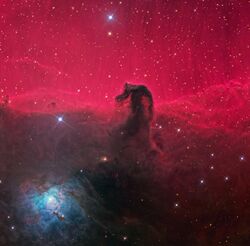Astronomy:NGC 2023
| Reflection nebula | |
|---|---|
| emission nebula | |
 NGC 2023 next to the Horsehead nebula | |
| Observation data: J2000 epoch | |
| Right ascension | 05h 41m 37.9s[1] |
| Declination | −02° 15′ 52″[1] |
| Distance | 1,300 ly (400 pc)[2] ly |
| Apparent dimensions (V) | 10'×10'[3] |
| Constellation | Orion[3] |
| Designations | NGC 2023,[3] LBN 954, IRAS 05391-0217[1] |
NGC 2023 is an emission and reflection nebula in the equatorial constellation of Orion. It was discovered by the Germany -born astronomer William Herschel on 6 January 1785. This reflection nebula is one of the largest in the sky,[4] with a size of 10 × 10 arcminutes.[3] It is located at a distance of 1,300 ly (400 pc) from the Sun, and is positioned ~15′ to the northeast of the Horsehead Nebula.[2]
This star-forming nebula forms part of the Orion B molecular cloud,[2] or Lynds 1630, and is located in the northern section of this complex. In terms of stellar density, it is the poorest of the four clusters embedded in the cloud complex, with only 21 embedded infrared sources.[5] The reflection nebula is illuminated by the Herbig Ae/Be star HD 37903, which has a spectral class of about B2 Ve.[5] The region around the central star is radiating fluorescent molecular hydrogen emission at a near-infrared range.[6][7] Infrared emission of polycyclic aromatic hydrocarbons has been detected from the nebula's dust.[8]
Gallery
NGC 2023 taken with the VLT's FORS.
References
- ↑ 1.0 1.1 1.2 "NGC 2023". SIMBAD. Centre de données astronomiques de Strasbourg. http://simbad.u-strasbg.fr/simbad/sim-basic?Ident=NGC+2023.
- ↑ 2.0 2.1 2.2 López-García, M. A. et al. (February 2013). "A comprehensive study of NGC 2023 with XMM-Newton and Spitzer". Monthly Notices of the Royal Astronomical Society 429 (1): 775–791. doi:10.1093/mnras/sts373. Bibcode: 2013MNRAS.429..775L.
- ↑ 3.0 3.1 3.2 3.3 Seligman, Courtney. "NGC Objects: NGC 2000 - 2049". http://cseligman.com/text/atlas/ngc20.htm#2023.
- ↑ "ESO's Very Large Telescope Snaps Beautiful Image of Reflection Nebula". May 14, 2019. http://www.sci-news.com/astronomy/reflection-nebula-ngc-2023-07186.html.
- ↑ 5.0 5.1 Mookerjea, B. et al. (December 2009). "Young stars and protostellar cores near NGC 2023". Astronomy and Astrophysics 507 (3): 1485–1502. doi:10.1051/0004-6361/200912550. Bibcode: 2009A&A...507.1485M.
- ↑ Burton, Michael G. et al. (1998). "Near-IR Fluorescent Molecular Hydrogen Emission from NGC 2023". Publications of the Astronomical Society of Australia 15 (2): 194–201. doi:10.1071/AS98194. Bibcode: 1998PASA...15..194B.
- ↑ Rouan, D. et al. (January 1997). "The power of adaptive optics: a close look at a molecular cloud in NGC 2023". Monthly Notices of the Royal Astronomical Society 284 (2): 395–400. doi:10.1093/mnras/284.2.395. Bibcode: 1997MNRAS.284..395R.
- ↑ Peeters, Els et al. (February 2017). "The PAH Emission Characteristics of the Reflection Nebula NGC 2023". The Astrophysical Journal 836 (2): 40. doi:10.3847/1538-4357/836/2/198. 198. Bibcode: 2017ApJ...836..198P.
External links
- "Sunset glow in Orion". NASA. 25 July 2011. http://www.spacetelescope.org/images/potw1130a/.
- VizieR – NGC 2023
- NED – NGC 2023
- NGC 2023 on WikiSky: DSS2, SDSS, GALEX, IRAS, Hydrogen α, X-Ray, Astrophoto, Sky Map, Articles and images
Coordinates: ![]() 05h 41m 37.9s, −02° 15′ 52″
05h 41m 37.9s, −02° 15′ 52″
 |



